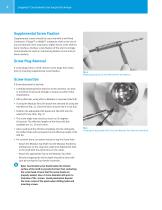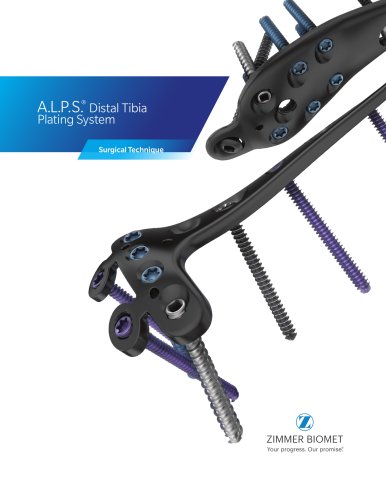 Website:
Zimmer Biomet
Website:
Zimmer Biomet
Group: Zimmer Biomet
Catalog excerpts

Surgical Technique Personal Fit Renewed Life™
Open the catalog to page 1
Longevity® Constrained Liner Surgical Technique Longevity Constrained Liner Product Indications for Use The Longevity Constrained Liner is indicated as a component of a total hip prosthesis in primary or revision THA where there is a high risk of hip dislocation due to a history of instability; bone loss; joint, muscle or tissue laxity; or disease condition. This device is intended for patients for whom all other options to constrained acetabular components have been considered. Manufactured from Longevity Highly Crosslinked Polyethylene Head diameters up to 36mm Retaining fingers capture...
Open the catalog to page 2
Longevity® Constrained Liner Surgical Technique Liner Removal Follow standard surgical techniques for shell insertion if a new shell is required, otherwise follow the steps below to remove existing liner. • Upon removal of any Liner, inspect the taper and polyethylene locking mechanism for damage. Non-Self tapping screw Polyethylene Liner Removal (Bone Screw Method) • Locate a 3.2mm or 3.5mm drill bit included in the Screw Kit. • Drill a pilot hole into the dome of the Liner between the pole and the taper region of the Shell. • Locate a non-self tapping screw. • A self tapping screw should...
Open the catalog to page 3
Longevity® Constrained Liner Surgical Technique Supplemental Screw Fixation Supplemental screws should be used only with a well-fixed Continuum, Trilogy IT or Allofit IT acetabular shell as the use of any constrained insert may lead to higher forces at the shell-tobone interface. Ancillary screw fixation of the shell is strongly recommended to assist in maintaining fixation at the shell-tobone interface. Screw Plug Removal If screw plugs exist in shell, remove screw plugs from holes prior to inserting supplemental screw fixation. Fig. 4 Attaching the bit to the Flex Drill with the Hex...
Open the catalog to page 4
Longevity® Constrained Liner Surgical Technique Screw Insertion (continued) • To loosen the set screw, turn it counterclockwise until the thread fully disengages from the flexible shaft. The set screw will be captured in the flexible drill shaft between the threads and the screw stop. (Fig. 6) • Alternatively, the set screw can be removed by turning it clockwise to fully disengage the set screw. Place it into the set screw holder in the instrument tray. • After either loosening or removing the set screw, remove the drill bit. After drilling the pilot or tapping the Screw hole: • Use the...
Open the catalog to page 5
Longevity® Constrained Liner Surgical Technique Provisional Liner Positioning • There are two styles of Provisional Liners. One with a Locking Screw that is independent of the Provisional Liner, and one with a Locking Screw permanently affixed within the Provisional Liner. The permanently affixed locking screw provisional liners are available in a Continuum/Trilogy IT version and an Allofit IT version to accommodate the polar screw threads of each shell system. The Allofit IT permanently affixed locking screw provisionals have offset curves etched at the pole for identification purposes...
Open the catalog to page 6
Longevity® Constrained Liner Surgical Technique • Important: The Provisional Liner is a direct representation of the assembled implant liner and constraining ring. Therefore, it is extremely important to make sure that all bone and soft tissue have been cleared from the periphery of the shell in order to help facilitate the proper seating of the liner provisional as well as the final implants. This is best accomplished by either direct visualization or by palpating the entire periphery of the shell. • The aim of the trial reduction is to locate the optimal rotational position of the...
Open the catalog to page 7
Longevity® Constrained Liner Surgical Technique Liner Insertion • Prior to inserting the Longevity Constrained Liner, ensure that the Shell interior is clean and dry. • Place the final polyethylene Liner into the implanted Shell by hand, or use the Liner Insertion Instrument. • Spin the Liner until scallops engage. Note: Before impaction, the polyethylene Liner will not be flush with the rim of the Shell. • Select the proper size constrained Liner Impactor Head and attach it to the Universal Handle. (Fig. 16) · Align the pins on the Universal Handle with the keyhole slot on the underside of...
Open the catalog to page 8
Longevity® Constrained Liner Surgical Technique Implant Assembly and Final Reduction Preparation of Constraining Ring To assemble the Longevity Constrained Liner, place the metal Constraining Ring over the head of the femoral component in the proper orientation (Fig. 18). The top-side of the ring with the two protruding fingers must point toward the femur. The underside of the ring, which will contact the face of the polyethylene liner, must be towards the patient’s acetabulum. Note: For clarification, the ring is engraved with “TOWARDS FEMUR” and “TOWARDS ACETABULUM” (Fig. 19). Femoral...
Open the catalog to page 9
Longevity® Constrained Liner Surgical Technique Constraining Ring Assembly to Insert • To attach the metal constraining ring to the insert, advance the ring from around the femoral neck to the face of the insert. (Fig. 21A) • To ensure proper alignment of the ring, the titanium pegs on the flat side of the reinforcement ring must fit into the slots on the outside of the polyethylene liner. • When properly positioned, the fingers of the metal ring are aligned with the fingers on the polyethylene liner. • There are two types of Ring Impactors available. The Axial Constraining Ring Impactor...
Open the catalog to page 10
Longevity® Constrained Liner Surgical Technique The constraining ring is fully seated when the metal constraining fingers are seated either flush or slightly below the level of the polyethylene constraining fingers on the liner and is consistent on both sides of the liner (Fig. 23). This will be palpable if direct visualization is not possible. If the metal constraining fingers are not seated flush/slightly below the polyethylene on both sides (Fig. 24), check that there is no soft tissue trapped between the constraining ring and the periphery of the shell or liner and repeat the impaction...
Open the catalog to page 11All Zimmer Biomet catalogs and technical brochures
-
MODULAR FEMORAL Revision System
14 Pages
-
A.L.P.S.®
44 Pages
-
Constrained Posterior Stabilized
12 Pages
-
Persona PERSONALIZED KNEE
7 Pages
-
Avenir® Femoral Hip System
12 Pages
-
The CLS® Spotorno® Stem
16 Pages
-
Alloclassic®Zweymüller®Stem
12 Pages
-
®Zimmer® Segmental System
6 Pages
-
NexGen® RH Knee
8 Pages
-
Persona-Partial
12 Pages
-
Zimmer Natural Nail System
8 Pages
-
tourniquet-systems-brochure
8 Pages
-
modern-cementing-technique
16 Pages
-
CoAxial Spray Kit
8 Pages
-
Biologics
24 Pages
-
PowerPump DP System
2 Pages
-
Sidus
40 Pages
-
Ankle Fix System 4.0
8 Pages
-
Anatomical Shoulder System
6 Pages
-
Fitmore Hip Stems
6 Pages
-
NexGen High-Flex Implant
8 Pages
-
Trabecular Metal ™Glenoid
4 Pages
-
Anatomical Shoulder ™ System
6 Pages
-
Zimmer ® PSI Shoulder
6 Pages
-
Zimmer personna
12 Pages
-
ZImmer iASSIST
44 Pages
-
Fitmore ® Hip Stem
24 Pages
-
Persona Knee
6 Pages
-
Trauma Solutions
10 Pages
-
Colagen Repair Patch
2 Pages
Archived catalogs
-
Fitmore® Hip Stem
6 Pages
-
Zimmer® Segmental System
6 Pages
























































































